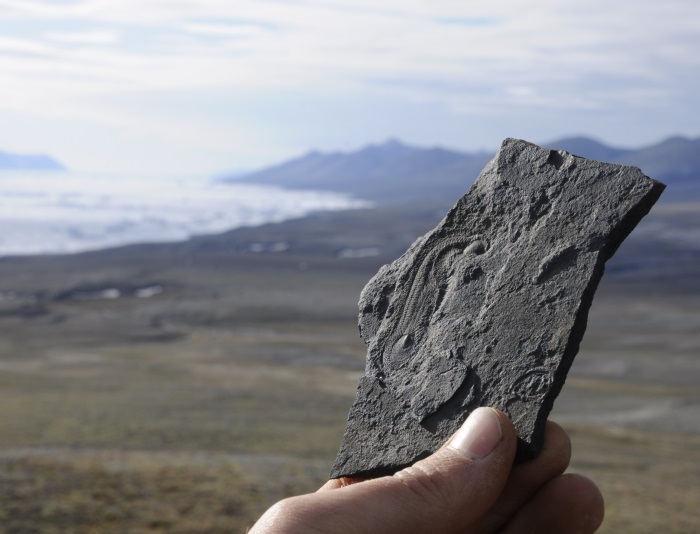Links to external sources may no longer work as intended. The content may not represent the latest thinking in this area or the Society’s current position on the topic.
Dating species divergences using rocks and clocks

Scientific discussion meeting organised by Professor Ziheng Yang FRS and Professor Philip Donoghue FRS
The molecular clock hypothesis provides the only viable framework for integrating molecular sequence and fossil age data to establish an evolutionary timescale. However, even after five decades since its proposal, the hypothesis remains controversial. This meeting will bring together scientists from molecular systematics, palaeontology, comparative genomics, and computational biology to discuss recent breakthroughs in the field and highlight future research directions.
Recorded audio of the presentations can be found below, and the related papers can be found online at Philosophical Transactions B.
Enquiries: Contact the events team
Organisers
Schedule
Chair

Professor Mike Benton FRS, University of Bristol, UK

Professor Mike Benton FRS, University of Bristol, UK
Michael Benton has made fundamental contributions to understanding the history of life, particularly biodiversity fluctuations through time. He has led in integrating data from living and fossil organisms to generate phylogenies – solutions to the question of how major groups originated and diversified through time. This approach has revolutionised our understanding of major questions, including the relative roles of intrinsic and extrinsic factors on the history of life, whether diversity reaches saturation, the significance of mass extinctions, and how major clades radiate. His research themes: a) diversification of life; b) phylogeny of diapsids and dinosaurs; c) dating the tree of life.
| 09:05 - 09:30 |
Why do we need a molecular clock?
Absolute times of species divergences are fundamental to biology, providing a means of calibrating organic evolution to geological time. Methods of establishing evolutionary timescales have evolved with new data and philosophies, developing from data interpreted in light of perceived trends, through more or less formalised approaches to combining stratigraphic age and comparative morphology, to the general abandonment of time as a factor in topology estimation, except where fossil records have been deemed sufficiently complete that phylogenies can be built from sequences of ancestor-descendent relations of morphospecies in the fossil record. Otherwise, palaeontologists have generally only sought to resolve relative relationships and calibrate them post hoc to geological time based on minimum age constraints that incomplete fossil records provide. The molecular clock hypothesis provides a means of supplementing such age constraints, by providing age estimates for clades that lack any fossil representation. Data on fossil species are nevertheless essential to disentangle times and rates of molecular evolution to generate estimates of absolute clade ages. Integration of fossil or other data in molecular clock dating analysis is a very active area of research, with recent Bayesian methods attempting to use more data than ever from the fossil record. Models of morphological character evolution allow fossil species to be included directly into molecular clock analyses, instead of indirectly informing clade ages. Diversification models have been developed that control for variation in the fossilization process, that account for uncertainties in fossil assignment, and that incorporate fossil ages with their associated uncertainty. However, those direct methods, without constraining node ages on the phylogeny, may be very sensitive to the prior or the assumed branching process, and, without the knowledge of the true divergence times, the veracity of these methods may be hard to assess. More than ever, it is important that molecular clock methods to accommodate the reality of molecular evolution and to assess the impact of the multiple factors that may influence the resolution of genetic distances in sequences into estimates of absolute times and rates. Given the limited amount of information in the fossil record, there may be hard limits to the precision in divergence time estimation that is achievable through addition of sequence data alone and it is important that such limits are considered in the deployment of this increasingly powerful tool. 
Professor Ziheng Yang FRS, UCL, UK

Professor Ziheng Yang FRS, UCL, UKZiheng Yang is the RA Fisher Professor of Statistical Genetics at Department of Genetics, Evolution, and Environment, University College London. He develops statistical methods and writes computer programs for phylogenetic and population genetics analyses of sequence data. His current research projects include estimation of species divergence times incorporating information from molecules and fossils, Bayesian phylogeographic analysis and species tree estimation under the multispecies coalescent model, and modelling protein evolution to understand the impact of selection. He is a Fellow of the Royal Society of London. He has won a few awards and published about 200 papers and 2 books. His recent book, Molecular Evolution: A Statistical Approach, has a pretty lizard on the cover. 
Professor Philip Donoghue FRS, University of Bristol, UK

Professor Philip Donoghue FRS, University of Bristol, UKPhilip Donoghue FRS is a palaeobiologist the University of Bristol whose research focusses on the integration of palaeontological and molecular insights into major evolutionary transitions, in particular, the evolutionary emergence of animals, but also the origin of land plants and early vertebrate evolution. |
|
|---|---|---|
| 09:30 - 10:00 |
The non-uniformity of fossil preservation
The fossil record provides the primary source of data for calibrating the origin of clades. Although minimum ages of clades are given by the oldest preserved fossil, these underestimate the true age, which must be bracketed by probabilistic methods based on multiple fossil occurrences. Although most of these methods assume uniform preservation rates, such an assumption is unsupported over geological timescales. On geologically long timescales (>10 Myr), the origin and cessation of sedimentary basins, and long-term variations in tectonic subsidence, eustatic sea level, and sedimentation rate control the availability of depositional facies that preserve the environments in which species lived. The loss of doomed sediments, those with a low probability of preservation, imparts a secular trend to fossil preservation. As a result, the fossil record is spatially and temporally nonuniform. Models of fossil preservation should reflect this non-uniformity by using spatially and temporally partitioned empirical estimates of fossil preservation or by using indirect proxies of fossil preservation. Geologically realistic models of preservation will provide more reliable estimates of the origination of clades. 
Professor Steven Holland, University of Georgia, USA

Professor Steven Holland, University of Georgia, USADr. Steven M. Holland is Professor in the Department of Geology and the Department of Marine Sciences at the University of Georgia. Dr. Holland's research interests center on the long-term response of marine invertebrate communities and sedimentary environments to sea-level change and climate change. His studies combine field-based sequence stratigraphy, numerical simulations of the stratigraphic and fossil records, and multivariate analysis of paleoecological communities. He has received the Charles Schuchert Award from the Paleontological Society and the James Lee Wilson Award from the Society for Sedimentary Geology. Dr. Holland serves on the Advisory Board of the Paleobiology Database, and he is President of the Paleontological Society. |
|
| 10:00 - 10:20 | Discussion | |
| 11:00 - 11:30 |
Extracting Absolute Chronologies from the Stratigraphic Record
The stratigraphic record is a remarkable yet incomplete archive of the evolution of life and environments on this planet over the past 4.567 billion years. The low preservation potential of sedimentary successions, due to both the variable creation of accommodation space and long-term tectonic cycles that result in fragmentation, modification and recycling of sedimentary sequences, is responsible for the imperfect nature of this unique archive. Interrogation of the stratigraphic record, as a means to assess linkages between geological, biological and environmental processes requires an independent framework within which geological, palaeontological and palaeo-environmental data can be objectively integrated. For over a century the decay of radionuclides to their stable daughter nuclides, with geologically significant half-lives, has been exploited to obtain absolute dates from rocks and minerals, underpins our current understanding of the quantification of absolute geological time and provides the temporal framework within which we can integrate disparate geological archives. Modern geochronology has evolved to the point where certain rocks and minerals can be dated with a range of radio-isotopic dating methods (e.g., U-Pb, Re-Os, K-Ar) with accuracy approaching the 0.1% level, and can be integrated with other proxies for time in the stratigraphic record, including magnetic field reversals and orbitally influenced cycles. These methods underpin the ongoing numerical calibration of the geological timescale and permit disparate geological archives to be objectively compared. The nature of the stratigraphic record is inherently limiting and geochronology increasingly plays a role in demarking areas of both certainty and uncertainty in how the stratigraphic archive can be translated into a high-fidelity record of Earth’s evolution. 
Dr Daniel Condon, British Geological Survey, UK

Dr Daniel Condon, British Geological Survey, UKThe stratigraphic record is a remarkable yet incomplete archive of the evolution of life and environments on this planet over the past 4.567 billion years. The low preservation potential of sedimentary successions, due to both the variable creation of accommodation space and long-term tectonic cycles that result in fragmentation, modification and recycling of sedimentary sequences, is responsible for the imperfect nature of this unique archive. Interrogation of the stratigraphic record, as a means to assess linkages between geological, biological and environmental processes requires an independent framework within which geological, palaeontological and palaeo-environmental data can be objectively integrated. For over a century the decay of radionuclides to their stable daughter nuclides, with geologically significant half-lives, has been exploited to obtain absolute dates from rocks and minerals, underpins our current understanding of the quantification of absolute geological time and provides the temporal framework within which we can integrate disparate geological archives. Modern geochronology has evolved to the point where certain rocks and minerals can be dated with a range of radio-isotopic dating methods (e.g., U-Pb, Re-Os, K-Ar) with accuracy approaching the 0.1% level, and can be integrated with other proxies for time in the stratigraphic record, including magnetic field reversals and orbitally influenced cycles. These methods underpin the ongoing numerical calibration of the geological timescale and permit disparate geological archives to be objectively compared. The nature of the stratigraphic record is inherently limiting and geochronology increasingly plays a role in demarking areas of both certainty and uncertainty in how the stratigraphic archive can be translated into a high-fidelity record of Earth’s evolution. |
|
| 11:30 - 12:00 |
A unified framework for inferring phylogenies with fossils
Molecular and fossil data are observations from the same speciation and extinction process. However, when dating (time-calibrating) phylogenies, we typically assume different models for the generation of the extant species phylogeny (obtained from the molecular data) and for the fossil data. While extant species phylogenies might be modelled through a speciation and extinction process, fossil occurrence times are modelled through arbitrary calibration densities. I will discuss our new approach assuming a speciation and extinction model simultaneously for both data types, together with a model for molecular and morphological evolution. We show in a simulation study the improvement in accuracy of dating phylogenies, while avoiding arbitrary calibration densities. The approach is available within Beast v2.0 and MrBayes. 
Professor Tanja Stadler, ETH Zurich, Switzerland

Professor Tanja Stadler, ETH Zurich, SwitzerlandTanja Stadler is an Assistant Professor at the Department of Biosystems Science and Engineering of the Swiss Federal Institute of Technology (ETH Zürich) in Basel since 2014. Tanja studied Applied Mathematics at the Technical University of Munich (Germany), the University of Cardiff (UK), and the University of Canterbury (New Zealand). She obtained a Master degree in 2006 and a PhD in 2008 from the Technical University of Munich (with Prof. Anusch Taraz and Prof. Mike Steel). Tanja then joined ETH Zürich as a postdoctoral researcher with Prof. Sebastian Bonhoeffer in the Department of Environmental Systems Sciences, and was promoted to Group Leader in 2011. Her work is at the interface of mathematics, computer science, evolution, ecology and infectious diseases. In particular, she develops phylogenetic tools to address epidemiological and medical questions, as well as questions in the fields of ecology, species evolution, cell differentiation and language evolution. Her honors include the TUM PhD award 2008, the John Maynard Smith prize 2012, the ETH Latsis prize 2013, and the Zonta prize 2013. In 2013, Tanja received an ERC starting grant. |
|
| 12:00 - 12:20 | Discussion |
Chair

Professor Tracy Heath, Iowa State University, USA

Professor Tracy Heath, Iowa State University, USA
Professor Tracy Heath is an assistant professor at Iowa State University in the department of Ecology, Evolution, and Organismal Biology. Her research focuses on developing Bayesian methods for phylogenetic inference. Professor Heath is particularly interested in methods for integrating fossil and molecular data and understanding macroevolutionary processes from species-level phylogenies. She is working on applying these approaches to biological data sets including penguins, crocodyliforms, turtles, and trilobites. Professor Heath received a PhD from the University of Texas at Austin and was a postdoctoral fellow at the University of Kansas and the University of California, Berkeley.
| 13:30 - 14:00 |
Closing the gap between rocks and clocks using total-evidence dating under the fossilized birth death model
Total-evidence dating allows evolutionary biologists to incorporate a wide range of sources of dating information (and uncertainty) into a unified statistical analysis. One might expect this to improve the agreement between rocks and clocks, but this is not necessarily the case. We explore the reasons for such discordance using a mammalian dataset with rich molecular, morphological and fossil information. Despite almost 37 kb of sequence data, there is still dramatic elasticity in divergence time estimates. Much of the uncertainty is apparently due to rampant convergence in the morphological data, causing a conflict between morphology and molecules that has a tendency to push estimated divergence times back in time under uninformative or incorrect priors. However, once tip sampling is modeled correctly, we show that informative prior assumptions that penalize unsampled “ghost” lineages tend to give quite close agreement between rocks and clocks. Such informative priors can involve assumptions of high (initial) net diversification, a low extinction rate, or a high fossilization rate; any of these assumptions alone, or any combination of them, produces highly congruent divergence time estimates with a minimal gap between rocks and clocks. The morphological plasticity makes it challenging to place the fossils correctly in the tree but the fossils nevertheless have a stabilizing influence on divergence time estimates and significantly increase the precision of those estimates. We conclude that total-evidence dating is not a panacea for dating problems, but it does give neontologists and paleontologists a common platform for understanding and addressing conflicts between different sources of dating information. 
Dr Fredrik Ronquist, Swedish Museum of Natural History, Sweden

Dr Fredrik Ronquist, Swedish Museum of Natural History, SwedenFredrik Ronquist is Professor and Head of the Department of Bioinformatics and Genetics at the Swedish Museum of Natural History. He was previously at the School of Computational Science at Florida State University and at the Department of Systematic Zoology at Uppsala University. He and his group is focused on Bayesian phylogenetic inference, often combining computational methods development with empirical research on the systematics and evolution of insects. Ronquist is one of the authors of the Bayesian phylogenetic inference software packages MrBayes and RevBayes. In recent years, his group has been working on more efficient ways of using fossil evidence in the dating of phylogenies, among other things. |
|
|---|---|---|
| 14:00 - 14:30 |
Examining the statistical behaviour of divergence-time estimation under the fossilized birth-death process

Professor John Huelsenbeck, University of California, USA

Professor John Huelsenbeck, University of California, USAJohn Huelsenbeck received his Ph.D. in 1995 in Zoology, studying the statistical properties of phylogenetic methods. He is currently a Professor in the Department of Integrative Biology at the University of California, Berkeley. His current research interests are in Bayesian phylogenetics, divergence time estimation, the analysis of genomic data, and statistical biogeography. |
|
| 14:30 - 14:50 | Discussion | |
| 15:30 - 16:00 |
At the crossroads between molecular dating, species diversification and morphological evolution - a Bayesian integrative modelling approach
Estimating divergence times, testing hypotheses about patterns of species diversification and analyzing morphological evolution are classically considered as separate research questions. However, many connections would deserve to be made between these various topics in macro-evolutionary sciences. Over the last years, several attempts at integrating some of these various aspects of macro-evolutionary sciences have been made, using hierarchical modeling approaches. Here, I will present a Bayesian framework, which extends previous developments, combining features of the molecular comparative method (Lartillot and Poujol, 2011, Mol Biol Evol 28:729) and of the total evidence dating paradigm (Ronquist et al, 2012, Syst Biol 61:973), in particular by considering fossils as tips. Taking as an input nucleotide sequence data for extant taxa, discrete and continuous characters for both extant and extinct taxa, as well as information about fossil ages, the program jointly estimates divergence times, patterns of morphological evolution and correlations between rates of molecular and morphological evolution. An application of the method to placental mammals will be presented, revealing extensive correlations between life-history, morphological and molecular evolution, while at the same time emphasizing the importance of the assumptions about species diversification for molecular dating. Altogether, this Bayesian approach represents a further step toward a complete integration between the classical comparative method, diversification studies and molecular dating. 
Professor Nicolas Lartillot, CNRS - Université Lyon, France

Professor Nicolas Lartillot, CNRS - Université Lyon, FranceNicolas Lartillot is a Researcher affiliated to the the French National Center for Scientific Research (CNRS), formerly in Montpellier (2004-2008), then in Montreal (2008-2013) and more recently in Lyon (since 2013). Most of his work is in computational evolutionary biology, being more specifically devoted to the application of Bayesian inference using Markov chain Monte Carlo to phylogenetics, molecular dating and macroevolutionary studies. He has developed Bayesian non-parametric models using Dirichlet processes to model variation in the substitution patterns along protein-coding sequences. These phylogenetic models have been implemented in the software program PhyloBayes. More recently, he has conducted new methodological developments on the side of the molecular comparative method, which is a generalization of the classical comparative method encompassing both molecular evolutionary quantities (substitution rates) and classical quantitative traits. This recent work is currently evolving towards more general integrative modelling strategies for macroevolutionary studies. |
|
| 16:00 - 16:30 |
"Total-evidence" Bayesian estimation of phylogeny, divergence times and fossil ages
Recent advances have allowed for both morphological fossil evidence and molecular sequences to be integrated into a single combined inference of divergence dates under the rule of Bayesian probability. In particular the fossilized birth-death tree prior and the Lewis-MK model of discrete morphological change allow for the estimation of both divergence times and the phylogenetic relationships between fossil and extant taxa. We exploit this statistical framework to investigate the internal consistency of these models by estimating the phylogenetic age of each fossil in turn, within a number of well-characterized data sets of fossil and extant species. We find that we can accurately estimate the age of individual fossils based only on phylogenetic evidence. For example, in two of the data sets we analyze the phylogenetic age of a fossil species is on average only 2 My from the midpoint age of the geological strata from which it was excavated. The high level of internal consistency found in our analyses provides strong evidence that the Bayesian statistical model employed is a good fit for both the geological and morphological data, and provides striking evidence from real data that the framework used can accurately model the evolution of discrete morphological traits coded from fossil and extant taxa. We anticipate that this approach will have diverse applications beyond divergence time dating, including dating fossils that are temporally unconstrained, testing the "morphological clock", and evaluating model assumptions when controversial phylogenetic hypotheses are obtained based on combined divergence dating analyses. 
Professor Alexei Drummond, University of Auckland, New Zealand

Professor Alexei Drummond, University of Auckland, New ZealandProfessor Drummond’s research interests are centered on probabilistic models of molecular evolution and population genetics, especially the application of coalescent theory to (i) estimate species trees and (ii) provide inferences about rapidly evolving viruses. Recently he has taken a renewed interest in the emerging field of phylogenetic epidemiology and is actively involved in the development of methods that enable estimation of fundamental epidemiology parameters directly from molecular sequence data. Professor Drummond is best known for two software packages: the open-source BEAST package for Bayesian phylogenetics (co-authored with Andrew Rambaut, Marc Suchard and many others) and the Geneious software package, developed by Biomatters Ltd (a company he is a Director and co-founder of). Alexei was recently awarded a 5-year Rutherford Discovery Fellowship by the Royal Society of New Zealand to develop a new version of the BEAST software package along with extensions to its evolutionary models. |
|
| 16:30 - 17:00 | Discussion |
Chair

Professor Max Telford, UCL, UK

Professor Max Telford, UCL, UK
Max Telford is Professor of Zoology at University College London. His zoology degree and PhD research were undertaken in the Department of Zoology in Oxford followed by postdoctoral training in Paris and the Natural History Museum in London. He held a Wellcome Trust career development fellowship, initially in the department of Zoology in Cambridge and then at UCL where he has worked since 2003. His research interests are focussed on early bilaterian evolution and involve molecular phylogenetics, comparative genomics and comparative embryology especially of the Xenacoelomorpha and Platyhelminthes.
| 09:00 - 09:30 |
Grouping substitution types into different relaxed molecular clocks
Different types of nucleotide substitutions experience different patterns of rate change over time. We propose grouping context-dependent (or context-independent) nucleotide substitution types according to how their rates change and then using the grouping for divergence time estimation. With our models, relative rates among types that are in the same group are fixed while absolute rates of the types within a group change over time according to a shared relaxed molecular clock. We illustrate our procedure by analyzing a 0.15Mb intergenic region to infer divergence times relating 8 primates. The different groupings of substitution types that we explore have little effect on the posterior means of divergence times, but the widths of the credibility intervals decrease as the number of groups increases. Potential improvements to our approach will be discussed. 
Professor Jeff Thorne, North Carolina State University, USA

Professor Jeff Thorne, North Carolina State University, USAJeff Thorne is a professor in the Biological Sciences and Statistics Departments of North Carolina State University. He was born in 1963 and spent most of his childhood in Wisconsin. His undergraduate degrees were in Molecular Biology and in Mathematics (University of Wisconsin, Madison). In 1991, he received a Ph.D. in Genetics from the University of Washington. His research concentrates on the development of statistical techniques for studying DNA sequence evolution. |
|
|---|---|---|
| 09:30 - 10:00 |
Do Bayesian credible intervals for divergence times lack credibility?
Modern approaches for inferring ages of clades on phylogenetic trees combine data from multiple fossil calibrations and DNA sequences of extant species. The most widely used methods apply Bayesian inference and generate the joint posterior distribution of divergence times. One way to summarize the uncertainty of the inferred ages is to consider the width of the credible set of values capturing 95% of the posterior probability. However, several plausible violations of the statistical model underlying a Bayesian analysis can generate overly-narrow credible intervals (i.e., the probability that the true parameter value is included in the set is much less that 95%). The sources of this problem are discussed and illustrated using example datasets generated by simulation. 
Professor Bruce Rannala, University of California Davis, USA

Professor Bruce Rannala, University of California Davis, USABruce Rannala is a Professor in the Department of Evolution and Ecology at UC Davis. He previously held positions on the faculty of SUNY Stony Brook and the University of Alberta and is currently a guest Professor at the Beijing Institute of Genomics, China. He was the Canadian Institutes of Health Research Peter Lougheed Scholar in 2001 and was appointed as a Miller Professor at UC Berkeley in 2009. Bruce Rannala's principal research interests include statistical aspects of population genetics, human genetics and phylogenetic inference. In particular, he has contributed to the development of Bayesian methods for phylogenetic inference and for population genetic inference. Bruce Rannala received a B.Sc. in Zoology from the University of British Columbia in 1989 and a Ph.D. in Biology from Yale University in 1995. He was an NSERC postdoctoral fellow at UC Berkeley. |
|
| 10:00 - 10:20 | Discussion | |
| 11:00 - 11:30 |
Uncertainty of Bayesian divergence time estimates and analysis of quantitative morphological characters
Molecular sequences for extant species provide information about the relative distances of species in a phylogeny, but not on the geological times of divergence or the molecular evolutionary rates. This statistical non-identifiably of times and rates is problematic, making posterior estimates of divergence times highly sensitive to uncertainties present in the rate prior and in the fossil-based probability densities used to calibrate the phylogeny. A way forward is provided by joint analysis of molecular and morphological characters of the species in the phylogeny. Here I discuss a method to estimate species divergence times using models of evolution of quantitative morphological characters in extant and fossil species. I focus on modelling the evolution of the shape of organisms (for example, point landmarks on fossil and extant skeletons) using diffusion models. The advantages of the method include easily incorporating correlations among characters, and ancestral reconstruction of fossil shapes at the internal nodes of the tree. However, the high variability of morphological evolutionary rates among lineages and uncertainties in fossil ages hamper our ability to obtain reliable estimates of species divergence times. 
Dr Mario dos Reis, Queen Mary University of London, UK

Dr Mario dos Reis, Queen Mary University of London, UKMario dos Reis was born in Venezuela, where he studied biology at Universidad Simon Bolivar. In 2000 he moved to the UK where he did an MSc and PhD in computational biology at Birkbeck College (London). In 2007 he moved to the National Institute for Medical Research (London) to work on the evolution of influenza viruses and on using the molecular clock to date the origin of influenza pandemics. Since 2010 he has been working at University College London on Bayesian statistical methods of the molecular clock to estimate species divergence times. |
|
| 11:30 - 12:00 |
Mutation rates and the evolution of germline structure
The rate of germline mutation is a fundamental quantity in molecular evolution, and determines the timescale by which we can relate genetic data to other evidence for the evolutionary past. It is also a quantity which evolves and differs between species. In particular, various lines of evidence suggest that the mutation rate in humans and other great apes is lower today than it was in at the time of their common ancestor, a phenomenon referred to as the hominoid slowdown. This evidence and what factors can contribute to the evolution of mutation rates will be explored. These include changes in life history such as generation time and puberty, which affect the yearly mutation rate, as well as processes affecting the underlying per-generation rate of mutation. Indeed the mutation rate and its evolution depend intimately on the structure of the germline, particularly in males. The nature of this relationship and how recent genome sequencing experiments suggest a revised model of stem cell transitions during spermatogenesis will be discussed. 
Dr Aylwyn Scally, University of Cambridge, UK

Dr Aylwyn Scally, University of Cambridge, UKDr Aylwyn Scally is based in the Department of Genetics at the University of Cambridge, working in computational genetics and genomics with a focus on human and primate evolution. His research uses computational methods with genome sequence data to understand ancestral demography and speciation. Before coming to genetics Dr Scally was a physicist, and received his Ph.D. in astrophysics from the University of Cambridge in 2001. |
|
| 12:00 - 12:20 | Discussion |
Chair

Dr Nick Goldman, EMBL - European Bioinformatics Institute, UK

Dr Nick Goldman, EMBL - European Bioinformatics Institute, UK
Nick Goldman has a first degree in mathematics and received his PhD in molecular evolution from the Department of Zoology, University of Cambridge, in 1992. He worked at the Natural History Museum (London), the MRC-National Institute for Medical Research (London) and the University of Cambridge before joining the European Bioinformatics Institute (EBI) in 2002. He leads a research group devising novel data analysis techniques for molecular evolution, and has published approximately 100 scientific papers. Nick is also an EMBL Senior Scientist and a member of EBI's Strategy and Management Committee.
| 13:30 - 14:00 |
Mammal madness: Is the mammal tree of life not resolved yet?
Living mammals (~5,400 species), inhabit every biome on earth, and are arguably one of the most phenotypically diverse group of vertebrates. From the largest, 170 ton blue whale, to the smallest, ~2 g flying, echolocating bumblebee bat, the huge diversity and extraordinary adaptive radiations in mammalian form and function have fascinated evolutionary biologists for centuries. Most molecular phylogenetic studies place all placental mammals into four superordinal groups: Laurasiatheria (e.g. dog, bat, cow), Euarchontoglires (e.g. human, rodent, flying lemur), Xenarthra (e.g. armadillo, ant-eater) and Afrotheria (e.g. elephant, sea-cow, tenrec) and estimate that they last shared a common ancestor 110 million years ago. This phylogeny has been the basis for many functional and comparative studies. However, a recent total evidence study examined the phylogenetic relationships amongst representative living and fossil mammals using a large supermatrix that combined ~4500 phenomic (morphological) characters, the largest morphological data set to date, with DNA sequences for 27 nuclear genes. Their results dramatically contrasted with prevailing molecular clock studies and suggested that approximated 10 interordinal mammalian divergences occurred in as little as 200,000 years, suggesting ‘viral rates’ of DNA mutations for mammals. Only 22/44 nodes that are supported by molecular studies were supported and many highly convergent ‘morphological’ clades received high support in their analyses. In addition despite the high level of congruence amongst most molecular studies, questions still remain regarding the position and divergence time of the root of placental mammals, and certain ‘hard clades’ such as Laurasiatheria and Paenungulata seem impossible to resolve. Here, we explore recent consensus and conflicting mammal phylogenetic studies and explore the reason for this conflict. The question of whether the mammal is or tree can be ever resolved will be addressed. 
Professor Emma Teeling, University College Dublin, Ireland

Professor Emma Teeling, University College Dublin, IrelandProfessor Emma Teeling established the Laboratory of Molecular Evolution and Mammalian Phylogenetics in 2005 and is the Founding Director of the Centre for Irish Bat Research at University College Dublin (UCD). She has been awarded a prestigious European Research Council Starting grant (2012) and a Science Foundation Ireland, President of Ireland Young Researcher Award (2006). She successfully leads a prolific, internationally renowned research team of typically 10 people and has secured over €4.5M in research funding. Prof. Teeling’s integrative research in the fields of zoology, phylogenetics and genomics uncovers the genetic signatures of survival that enables species to adapt to an ever-changing environment. The two mains goals of her research are: (1) study unique model species to enable a better understanding of the structure and function of the human genome to inform medicine and molecular biology; (2) understand and therefore conserve, natural populations and environments to promote ecosystem well-being and functioning. Her record of leadership and research excellence is demonstrated by her publication record of 68 internationally peer-reviewed papers, 5 book chapters, 3 invited subject reviews. A number of these publications have over-turned conventional paradigms in mammalian biology and therefore have been published in high profile journals such as Nature (n=1), Science (n=4), Proceedings of the National Academy of Sciences (n=3), and Nature Communications (n=1). Her high standing in the international community is highlighted by a total citation record of 4578; prestigious international keynote lectures; invited high profile collaborations such as Genome 10K (includes 64 scientific leaders assembled to sequence 10,000 vertebrate genomes); and, high profile invited public presentations (e.g. TEDx talk; ~ 405,000 views; BBC’s Science Club with Dara O’Brian). |
|
|---|---|---|
| 14:00 - 14:30 |
Molecular Palaeobiology of arthropod terrestrialisation: is the gap closing?
Members of the phylum Arthropoda (e.g. insects, centipedes, spiders, crabs and their allies) are the first animals to appear in the terrestrial fossil record. Accordingly, dating the arthropod radiation is fundamental to understand animal terrestrialisation more broadly. However, there is still substantial disagreement between the fossil record of the terrestrial arthropods, and the molecular divergence times for the major arthropod lineages. Furthermore, to clarify how terrestrial arthropods colonized lands it is paramount to clarify the phylogenetic relationships between marine and terrestrial arthropod lineages. For example, it has recently been suggested that the remipedes, a small group of crustaceans exclusively known from marine caves, might represent the sister group of the insects. If this result was confirmed it would suggest a complex route to insect terrestrialisation. However, the evidence proposed to support a close relationship between remipedes and insects is weak at best, and an alternative scenario where the branchipod crustaceans (e.g. the fairy shrimps) that are mostly known from freshwater represent the sister group of the insects should still be considered a valid alternative. Here we shall revise current knowledge of arthropod phylogeny and molecular divergence times within this lineage and interpret these results to better elucidate what processes might have led animals to first colonise the land. 
Dr Davide Pisani, University of Bristol, UK

Dr Davide Pisani, University of Bristol, UKDavide Pisani graduated in Natural Sciences at the University of Parma, Italy in 1998. After that he completed a PhD in computational biology at the University of Bristol in 2001. He carried out postdoctoral work at the Pennsylvania State University, and at the Natural History Museum, London. After that he was awarded a Marie Curie fellowship and moved to Ireland in 2005. He was lecturer of Bioinformatics at the National University of Ireland from 2007 to 2012, when he moved back to Bristol where he now is Reader in Phylogenomics. Dr Pisani uses phylogenetic and molecular clock based approaches to study the major transitions in the history of life, and he is particularly interested in early animal evolution, origin of animals, animal terrestrialisation. Other topics of interest include eukaryotic evolution and theoretical phylogenetics. |
|
| 14:30 - 14:50 | Discussion | |
| 15:30 - 16:00 |
Inferring the influence of past climate change on megafaunal population dynamics
In combination with a molecular clock, genomic data isolated from the remains of long-dead plants and animals can reveal the timing and nature of demographic processes. When coupled with environmental data, genetic reconstructions can begin to address not only when populations grew or shrank, but also why. Broad sampling of faunal remains across the northern hemisphere has shown, for example, that most megafaunal population sizes fluctuate considerably over the last glacial cycle (ca. 125,000 years). However the sparseness of sampling and wide range of environmental variation across the northern hemisphere makes it difficult to identify which environmental processes are driving these demographic changes. In this session, I will present the results of a new analysis of genetic data from caballine horses (Equus caballus) and a variety of environmental proxies, including isotopic, insect, and plant macro- and microfossil data, that were collected at a single location – the Klondike region of Canada’s Yukon Territory. Our data span the last 50,000 years, a period that includes both the transition into and out of the coldest part of the last ice age, making it possible to trace the influence of specific environmental changes on North American horse survival and extinction. 
Professor Beth Shapiro, University of California Santa Cruz, USA

Professor Beth Shapiro, University of California Santa Cruz, USABeth Shapiro is an evolutionary biologist who specializes in the genetics of ice age animals and plants. A pioneer in the young field called “ancient DNA,” Beth travels extensively in the Arctic regions of Alaska, Siberia and Canada collecting bones and other remains of long-dead creatures including mammoths, giant bears, and extinct camels and horses. Using DNA sequences extracted from these remains, she hopes to better understand how the distribution and abundance of species changed in response to major climate changes in the past, and why some species go extinct while others persist. The results could be used to help develop strategies for the conservation of species that are under threat from climate change today. Professor of Ecology and Evolutionary Biology at University of California Santa Cruz and a research associate of the Denver Museum of Natural History, Shapiro has been widely honoured for her research. She has been named a Royal Society University Research Fellow, Searle Scholar, Packard Fellow, and a National Geographic Emerging Explorer. In 2009, she received a MacArthur “genius” award. |
|
| 16:00 - 16:30 |
Fossilized birth/death dating applied to beeches (Fagus) and ferns (Osmundaceae), clades with excellent fossil records
The fossilized birth-death (FBD) method of calibrating molecular clocks makes use of both young and old fossils, and is a tip-dating method in that it treats the fossils as tips in MCMC runs. Simulations have shown that method is able to infer speciation, extinction, and fossil recovery rates. With colleagues, I have applied FBD dating to the northern hemisphere genus Fagus, using 45 fossils and nuclear sequences for all nine species, and the worldwide fern clade Osmundaceae, using 35 fossils and sequences for all 12 living species. For both clades, the inferred divergence times were older than obtained with standard node dating. Visualization of the results was easy for the Osmundaceae consensus chronogram, but not for Fagus for which network visualization helped identify and place ‘rogue’ fossils. Inferred speciation and extinction rates imply a ca. 5x higher evolutionary turnover in Fagus than in Osmundaceae, fitting the hypothesized low turnover in plants, such as these ferns, adapted to low nutrient conditions. Only three empirical studies have used the FBD approach so far, which seems surprising given its conceptual superiority to node dating. 
Professor Susan Renner, University of Munich, Germany

Professor Susan Renner, University of Munich, GermanySusanne Renner is an evolutionary biologist, interested in plant sexual systems, plant/pollinator interactions, and in the occupation of space by plant lineages. Her approaches combine comparative biology and molecular phylogenetics. Right now, her lab is focusing on the evolution of Y chromosomes in certain cucurbits, ant/plant symbioses, and the evolution of different leaf-out strategies in woody species. Well-calibrated molecular clocks are essential to her research. She has worked in Manaus, Brazil; at the Smithsonian Institution, and at universities in Aarhus (Denmark), Mainz (Germany), and Saint Louis (USA). Since 2003, she’s been at the University of Munich, where she is also the director of the Munich botanical garden and herbaria. |
|
| 16:30 - 17:00 | Discussion |
